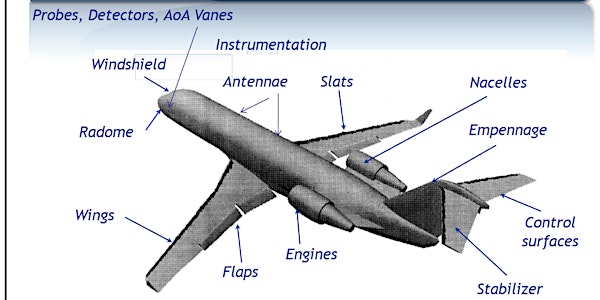For an aircraft, rotorcraft or jet engine to obtain a type design certification, it must be demonstrated that it can sustain safe flight into known or inadvertent icing conditions. The icing certification process involves CFD (Computational Fluid Dynamics) analyses, wind andicing tunnel testing (EFD: Experimental Fluid Dynamics), all considered “simulation”, and final demonstration of compliance through Flight Testing in Natural Icing (FFD: Flight Fluid Dynamics). Modern 3D CFD-Icing methods such as FENSAP-ICE, working as a direct extension of CFD-Aero technologies, have become an indispensable, if not a primary tool, in the certification process. They are rapidly replacing 2D and 2.5D methods (airfoils don’t fly; aircraft do). They enable analyzing the aircraft (fuselage, wing, engines, nacelles, cockpit windows, sensors, probes, etc.) as a system and not as an assemblage of isolated components. The judicial integration of CFD-EFD simulation tools provides a cost-effective aid to-design-and-to-certification, when made part of a well-structured compliance plan. CbA (Certification-by-Analysis) being a current “hot” subject; this course puts it into real practice, providing efficient tools and showing examples of capabilities and limitations.The course will show how modern 3D icing codes are based on highly validated physical models (Scientific VVV) as opposed to a Catch-22 calibration of codes against icing tunnels to yield heuristic models. The course will also show how Reduced Order Models can make fully-3D calculations inexpensive (yielding 3D CFD with 10-20 million points + impingement + icing + performance in 1/100th of a second, after the calculation of an appropriate number of “snapshots”: this is even faster than 2D panel methods calibrated codes!) and enable rapid identification of aerodynamic and thermodynamic critical points in a structured way and not a heuristic one. By inclusion of icing requirements at the aerodynamic design stage, a more comprehensive exploration of the combined aerodynamics/icing envelopes, optimized IPS design, and focused/reduced wind tunnels, icing tunnels and flight tests. The end result is a faster design, faster testing, faster natural icing campaign, and a safer aircraft that is easier to certificate.This course is structured to be of equal interest to aerodynamicists, icing, environmental systems and flight simulation engineers, regulators and Designated Engineering Representatives. Detailed knowledge of CFD is not necessary.The lectures cover the major aspects of in-flight icing simulation, ice protection systems, handling quality issues. The instructors bring an amalgam of knowledge, as scientists who have produced codes in current use and engineers with certification experience, along with cost-effective simulation methods widely used internationally for certification of aircraft for flight into known icing.
